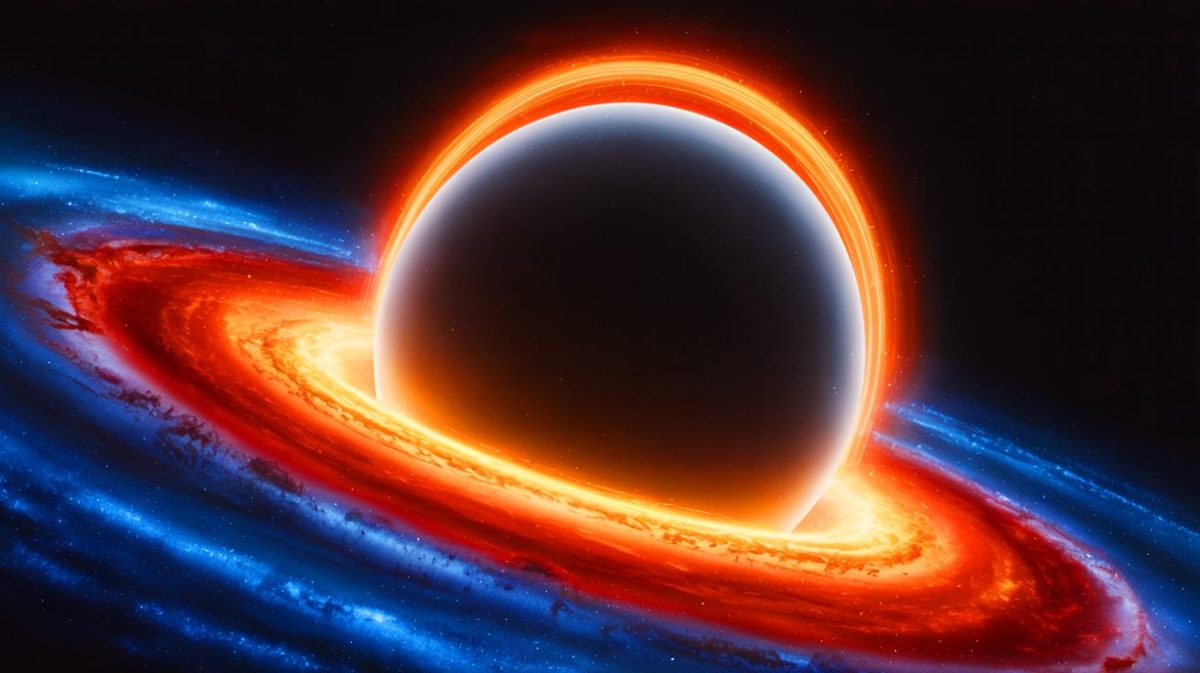| IN A NUTSHELL |
|
The discovery of a dormant ultramassive black hole, 36 billion times the mass of the Sun, marks a significant milestone in our understanding of the universe. Found at the heart of the Orange Galaxy, this black hole is part of a fossil group, a cosmic structure marking the endgame of galactic evolution. Located some 5 billion light-years from Earth, this black hole’s presence was detected through the gravitational effects it exerts on its surroundings, rather than through radiation or matter consumption. This groundbreaking discovery opens new avenues for understanding the evolution of galaxies and the role of black holes within them.
The Science Behind Gravitational Lensing
Gravitational lensing is a pivotal technique used to uncover the dormant black hole at the center of the Cosmic Horseshoe. This galaxy is so massive that it bends the light from a background galaxy into a horseshoe shape. By studying this effect, astronomers can infer the presence of the black hole without relying on traditional detection methods. The technique allows scientists to look deeper into the universe and identify objects that might otherwise remain hidden.
According to Carlos Melo, the lead researcher from the Universidade Federal do Rio Grande do Sul, the detection of this black hole relied on its tremendous gravitational influence. By observing the stars near the galaxy’s center, which move at speeds nearing 400 kilometers per second, researchers confirmed the black hole’s existence. This approach provided a level of certainty about the black hole’s mass that is often lacking in other methods.
Professor Thomas Collett from the University of Portsmouth emphasized the importance of combining stellar kinematics with gravitational lensing. This combination allowed the team to confidently assert the black hole’s reality and its immense size. The successful application of these techniques marks a significant advancement in astrophysics, enabling scientists to explore the universe’s distant reaches with greater accuracy.
The Implications of Galaxy Evolution
The Orange Galaxy, home to the newly discovered black hole, is part of a fossil group. These structures form when a cluster of galaxies merges into a single dominant entity. This process often leads to the formation of ultramassive black holes, as smaller supermassive black holes coalesce over time. The discovery suggests that the growth of black holes is closely linked to the evolution of their host galaxies.
As galaxies evolve, they feed matter into their central black holes. Some of this matter is consumed, while the rest is expelled as energetic jets known as quasars. These quasars can significantly impact the host galaxy by heating and dispersing gas, thus preventing new stars from forming. The relationship between black holes and their host galaxies is a subject of ongoing research, with significant implications for our understanding of cosmic evolution.
This discovery also sheds light on the future of our Milky Way. With a relatively modest black hole at its center, the Milky Way is expected to experience significant changes in the future. When it eventually merges with the Andromeda Galaxy, the central black hole could reignite into a quasar, reshaping the galaxy’s structure and star formation.
Unexpected Discoveries and Future Research
The discovery of the ultramassive black hole was serendipitous. Researchers initially set out to study the distribution of dark matter in the Cosmic Horseshoe. However, the signature of the black hole emerged unexpectedly, demonstrating the power of combining various astronomical techniques. This unintentional finding has validated the researchers’ methods, paving the way for future discoveries.
The European Space Agency’s Euclid space telescope will play a crucial role in future research. By applying the validated methods to data collected by Euclid, scientists hope to uncover more hidden giants across the universe. These findings could revolutionize our understanding of the universe’s structure and the role of black holes in cosmic evolution.
The study, published in the Monthly Notices of the Royal Astronomical Society, marks a significant step forward in astrophysics. As researchers continue to refine their techniques and explore the universe’s depths, new discoveries are likely to change our understanding of the cosmos. The implications of these findings extend beyond academic interest, offering insights into the fundamental processes that shape our universe.
The Future of Black Hole Research
Black holes have long fascinated scientists and the public alike. The discovery of this dormant black hole, one of the heaviest ever detected, highlights the dynamic and complex nature of these cosmic entities. As research continues, scientists aim to unravel the mysteries surrounding black holes and their interactions with their host galaxies.
This discovery also underscores the importance of technological advancements in astronomy. The combination of techniques such as gravitational lensing and stellar kinematics allows researchers to explore new frontiers in the universe. As these methods are further refined, the potential for groundbreaking discoveries increases.
The study raises intriguing questions about the future of black hole research. How will new technologies continue to enhance our understanding of black holes? What other hidden giants lie waiting in the universe, and what can they reveal about the cosmos? As we continue to explore the universe’s depths, these questions will guide our quest for knowledge.
Did you like it? 4.7/5 (26)








Wow, a 36-billion-sun black hole! That’s a cosmic heavyweight champion! 🏆
How do they even measure something that’s 5 billion light-years away? 🤔
This is so fascinating! Thanks for sharing such an amazing discovery! 🌌
I wonder if the Orange Galaxy is made of oranges… 🍊 Just kidding! 😄
Gravitational lensing sounds like a sci-fi superpower. How does it work exactly?
Can someone explain what a “fossil group” is? I’m a bit lost!
Does this discovery change anything about our understanding of the universe?
Is it normal for black holes to be dormant? What wakes them up?
I’m skeptical 🤨… How can we be sure this black hole exists?
Thank you for the detailed explanation. This is truly groundbreaking! 📡